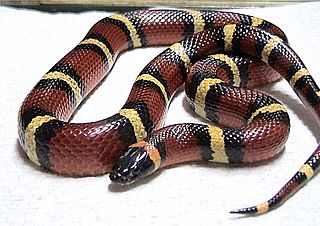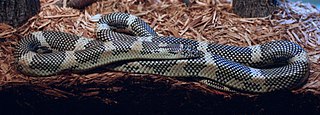
The milk snake or milksnake, is a species of kingsnake; 24 subspecies are currently recognized. Lampropeltis elapsoides, the scarlet kingsnake, was formerly classified as a 25th subspecies, but is now recognized as a distinct species. The subspecies have strikingly different appearances, and many of them have their own common names. Some authorities suggest that this species could be split into several separate species. They are not venomous to humans.

Kingsnakes are colubrid New World members of the genus Lampropeltis, which includes 26 species. Among these, about 45 subspecies are recognized. They are nonvenomous and ophiophagous in diet.

The California kingsnake is a nonvenomous colubrid snake endemic to the western United States and northern Mexico, and is found in a variety of habitats. Due to ease of care and a wide range of color variations, the California kingsnake is one of the most popular snakes in captivity.

The scarlet kingsnake or scarlet milk snake is a species of kingsnake found in the southeastern and eastern portions of the United States. Like all kingsnakes, they are nonvenomous. They are found in pine flatwoods, hydric hammocks, pine savannas, mesic pine-oak forests, prairies, cultivated fields, and a variety of suburban habitats; not unusually, people find scarlet kingsnakes in their swimming pools, especially during the spring. Until recently, and for much of the 20th century, scarlet kingsnakes were considered a subspecies of the milk snake; however, Pyron and Bubrink demonstrated the phylogenetic distinction of this species and its closer relationship to the mountain kingsnakes of the southwestern United States. These largely fossorial snakes are the smallest of all the species within the genus Lampropeltis, usually ranging from 40 to 50 cm at maturity. The maximum recorded length is in Jonesboro, AR 76.2 cm (30.0 in). Hatchlings range in size from 8 to 18 cm .

Coral snakes are a large group of elapid snakes that can be divided into two distinct groups, the Old World coral snakes and New World coral snakes. There are 27 species of Old World coral snakes, in three genera, and 83 recognized species of New World coral snakes, in two genera. Genetic studies have found that the most basal lineages have origins in Asia, suggesting that the group originated in the Old World. While new world species of both genera are venomous, their bites are seldom lethal; only two confirmed fatalities have been documented in the past 100 years from the genus Micrurus. Meanwhile, snakes of the genus Micruroides have never caused a medically significant bite.

The desert kingsnake is a species of kingsnake native to Texas, Arizona, and New Mexico, United States. It is not venomous, colored yellow and black. The desert kingsnake's diet consists of rodents, lizards, and smaller snakes, including rattlesnakes. They normally grow 3–4 ft long, but have been known to grow up to 6.8 ft. They are docile creatures when confronted by humans. If they do not try to escape, often they "play dead" by flipping over onto their backs and lying motionless. Some who domesticate kingsnakes, such as ranchers, do so in the hopes that the kingsnakes will feed on other snakes, which might present more of a threat. It was previously considered a subspecies of the common kingsnake. The desert kingsnake belongs to the Colubridae family, which is the largest family of snakes in the world.

The gray-banded kingsnake, sometimes referred to as the alterna or the Davis Mountain king snake, is a species of nonvenomous snake in the family Colubridae. The species is endemic to the southwestern United States and adjacent Mexico. Some sources list two distinct subspecies of Lampropeltis alterna, as L. a. alterna and L. a. blairi differentiated by patterning and locale, but research has shown them to be color morphs of the same species.

Aridoamerica denotes an ecological region spanning Northern Mexico and the Southwestern United States, defined by the presence of the culturally significant staple foodstuff Phaseolus acutifolius, a drought-resistant bean. Its dry, arid climate and geography stand in contrast to the verdant Mesoamerica of present-day central Mexico into Central America to the south and east, and the higher, milder "island" of Oasisamerica to the north. Aridoamerica overlaps with both.

The speckled kingsnake is a species of nonvenomous kingsnake in the family Colubridae. The species is endemic to the United States.

Lampropeltis annulata, commonly known as the Mexican or Tamaulipan milksnake, is a non-venomous species of milksnake. The species is native to northwestern Mexico and some adjacent United States-Mexico border regions.

Nelson's milksnake is a subspecies of king snake that is found in Mexico from southern Guanajuato and central Jalisco to the Pacific Coast. It is also found on the narrow plains of northwestern Michoacán and on the Tres Marias Islands. The range of this snake appears to be tied to the proximity of watercourses, including ones utilized for irrigation and agriculture. It is a subspecies of the milksnake, Lampropeltis triangulum. It is similar in size to other king snakes, averaging 42 inches (110 cm) long, and like them, it is nonvenomous.

Lampropeltis triangulum sinaloae, commonly known as the Sinaloan milk snake, is an egg-laying subspecies of nonvenomous colubrid snake. It is one of the most commonly bred milk snakes in captivity. It is a fairly docile subspecies and will rarely bite. However, if handled, it may discharge a pungent smelling exudate from the cloaca as a warning. The Sinaloan milk snake inhabits the rocky and semi-arid drylands of southwestern Sonora, Sinaloa, and southwestern Chihuahua (Mexico).

Lampropeltis getula, commonly known as the eastern kingsnake, common kingsnake, or chain kingsnake, is a harmless colubrid species endemic to the United States. It has long been a favorite among collectors. Four subspecies are currently recognized, including the nominate subspecies described here. All of these taxa had originally been described as distinct species and recognized as such for up to 101 years.

The Apalachicola kingsnake is a subspecies of nonvenomous colubrid snake found in a small area of the Florida Panhandle known as the Apalachicola Lowlands. Long argued as to whether or not it is a subspecies, the Apalachicola kingsnake was formerly named Lampropeltis getula goini. After years of research and many more specimens examined, in 2006, it was renamed to L. g. meansi after D. Bruce Means, in recognition of his work on this subspecies.

Micruroides is a genus of venomous coral snake in the family Elapidae. The genus is monotypic, containing only the species Micruroides euryxanthus.

Lampropeltis nigra, commonly known as the black kingsnake, is a species of nonvenomous colubrid snake indigenous to the United States. It is a species of kingsnake.

Lampropeltis mexicana thayeri, currently known as lampropeltis leonis, or Nuevo León kingsnake, variable kingsnake, or Thayer's kingsnake, is a nonvenomous snake belonging to the family Colubridae. Thayer's kingsnake is a subspecies of the mexicana group of the genus Lampropeltis. Thayer's kingsnake is endemic to the eastern slopes of the Mexican plateaus in Tamaulipas, Mexico. Thayer's kingsnake is known for producing offspring typically displaying three main variable phases within the same clutch from similar-coloured patterned parents.

Lampropeltis mexicana, the Mexican kingsnake, is a colubrid snake that is endemic to Mexico.



















